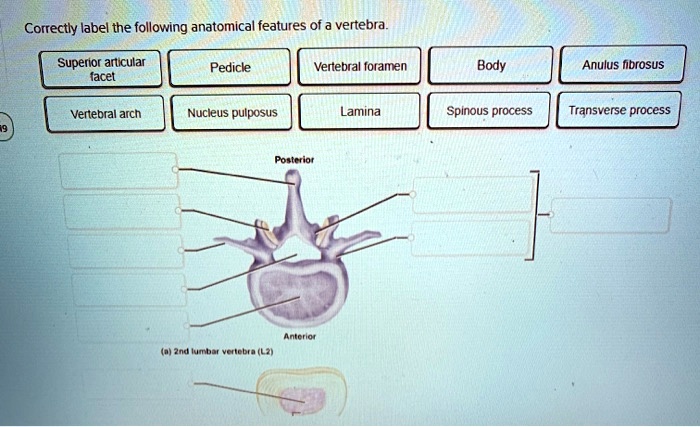Correctly label the following anatomical features of a vertebra. – Correctly labeling the anatomical features of a vertebra is essential for understanding its structure and function. This guide provides a comprehensive overview of the key anatomical features of a vertebra, including the vertebral body, vertebral arch, vertebral foramen, transverse processes, spinous process, laminae, pedicles, and facet joints.
Vertebrae Anatomy

Vertebrae are the individual bones that make up the spinal column. They provide structural support, protect the spinal cord, and allow for movement of the spine. Each vertebra has a complex structure with several distinct anatomical features.
The main anatomical features of a vertebra include:
- Vertebral body
- Vertebral arch
- Vertebral foramen
- Transverse processes
- Spinous process
- Laminae
- Pedicles
- Facet joints
Vertebral Body
The vertebral body is the large, anterior portion of the vertebra. It is cylindrical in shape and forms the main weight-bearing component of the spine. The vertebral body provides structural support and helps to distribute the load of the body’s weight evenly throughout the spine.
Vertebral Arch
The vertebral arch is a ring-shaped structure that extends posteriorly from the vertebral body. It consists of two pedicles and two laminae that meet at the midline to form the spinous process.
Vertebral Foramen
The vertebral foramen is the opening in the center of the vertebral arch. It is through this opening that the spinal cord passes.
Transverse Processes
The transverse processes are two bony projections that extend laterally from the vertebral arch. They provide attachment points for muscles and ligaments.
Spinous Process
The spinous process is a single, bony projection that extends posteriorly from the vertebral arch. It provides a lever arm for muscles that attach to the spine.
Laminae
The laminae are two flat, plate-like bones that form the posterior wall of the vertebral arch. They meet at the midline to form the spinous process.
Pedicles
The pedicles are two short, thick bones that connect the vertebral body to the vertebral arch. They form the lateral walls of the vertebral foramen.
Facet Joints, Correctly label the following anatomical features of a vertebra.
The facet joints are synovial joints that are located between the articular processes of adjacent vertebrae. They allow for movement of the spine.
FAQs: Correctly Label The Following Anatomical Features Of A Vertebra.
What is the function of the vertebral body?
The vertebral body provides structural support for the spine and helps to distribute weight evenly.
What is the vertebral foramen?
The vertebral foramen is the opening in the center of the vertebra through which the spinal cord passes.
What are the transverse processes?
The transverse processes are projections on the sides of the vertebra that provide attachment points for muscles and ligaments.
What is the spinous process?
The spinous process is a projection on the back of the vertebra that provides attachment points for muscles and ligaments.
What are the laminae?
The laminae are the flat plates that form the roof of the vertebral arch and help to protect the spinal cord.
What are the pedicles?
The pedicles are the short, thick stalks that connect the vertebral body to the vertebral arch.
What are the facet joints?
The facet joints are the small, synovial joints between adjacent vertebrae that allow for limited movement of the spine.


